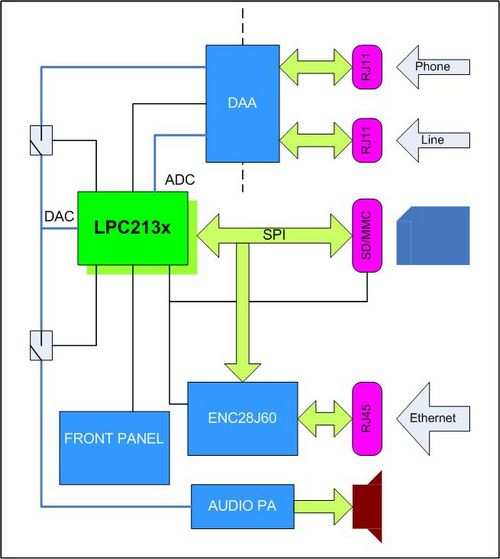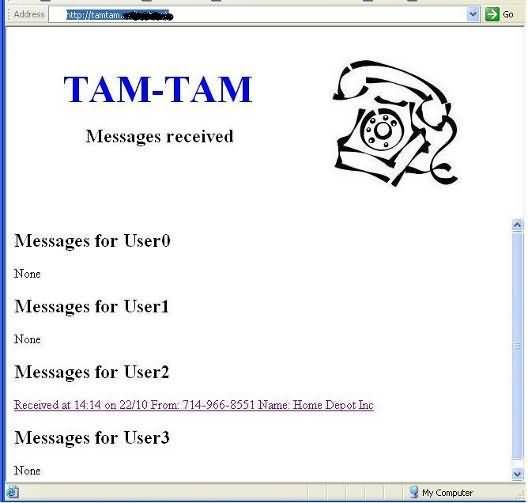
The Active Kiosk Telephone Answering Machine TAM-TAM is the 21st century version of a common home or small office device: the Answering Machine. It solves many of the problems inherent in its 20th century predecessor: confusing user interface, poor audio quality, limited storage capacity, and lack of worldwide connectivity. All these limitations are addressed by TAM-TAM, which has outstanding sound quality and an almost unlimited storage capacity thanks to the use of an external flash memory card.
The user interface is very simple and consists of a plain text file that can be edited and modified at will on a Personal Computer. This simple configuration process creates up to 4 virtual answering machines, protecting each user from spam messages. Worldwide connectivity is provided by a backend Internet connection used for notification (SMS or E-mail message) and message reception. The latter is done for free with a web browser.

Since Ethernet plugs are not available in every home, TAM-TAM connects to the home wireless network via a Wireless bridge. From a technical perspective, TAM-TAM is also a platform that demonstrates that small RISC processors can now implement DSP-like functions in C that were previously assigned to fixed-function ICs. The same RISC processor also runs higher level tasks such as the IP stack and solid-state File System.
DSP-like functions include: FSK demodulation, audio playback and recording, tone generation and detection, and DTMF detection. TAM-TAM provides clean and reusable modules that can be easily ported to other products. TAM-TAM implements proven algorithms that are simulated to show a good level of performance. For example, the FSK demodulator is a “true” demodulator that demonstrates a much higher level of performance than can be achieved with zero-crossing implementation.
The hardware side of TAM-TAM includes 4 main blocks:
ARM based processing unit
SD/MMC card interface
ethernet block
Telephone line interface, also known as DAA
MMC/SD flash card interface
PC compatible File System
Wave file playback and recording
Tone detection and generation
DTMF detection
Caller ID demodulation
TCP/IP stack
web server
A simple power supply (linear regulator) and an integrated audio amplifier are also part of the system. Since audio files are created on a computer, there is no need to implement a microphone subsystem. Files can be created and mixed on a computer, then copied to a flash card that is easily inserted into the front panel of the answering machine.
The processing unit is based on a Philips LPC2138 microcontroller. The main engine of LPC2138 is an ARM7 RISC engine. ARM7 is “surrounded” by peripherals that significantly reduce the number of external components required in such a project:
Integrated Digital to Analog (DAC) and Analog to Digital (ADC) blocks are at the heart of DSP and audio Recording/Playback functionality. Their use is multiplexed across different tasks. In some cases, they can be used together (such as when providing audio feedback in recording mode).
GPIOs are used to control the LEDs (after sufficient buffering), the telephone line interface (on and current sensing), and two chip selectors, and to collect inputs from switches, current detectors, and the flash card socket.
Serial Peripheral Interface (SPI) is shared between the SD/MMC card and the Ethernet interface. This allows 3 control lines (plus a choice of chips per device) to perform functions that would normally require a complete Address, Data and Control bus.
Timers provide the time base for the ADC and DAC, Time of Day tracking, and overall scheduling for the IP stack and other background tasks. From a software perspective, it does not use a FULL operating system. Instead, it relies on an endless loop that activates different “tasks” depending on external events (e.g. the phone ringing). On the other hand, TAM-TAM makes heavy use of interruptions. The main interrupt occurs at 8000 (or 9600) Hz and usually triggers an ADC readout, a DAC sample output, or in some cases both.

Şifre-Pass: 320volt.com
Published: 2010/05/23 Tags: arm project, microcontroller projects
LPC2138 arm microcontroller generates vga signals
NoPC is an creation bleach for dynamical a VGA lizard without a PC. This single group is soigne yet retarded. A CPU muck is used to run a VGA protector, a keyboard, and a mouse, with ample module for storage, all without a PC. An LPC2138 microcontroller generates the VGA signals that thrust the protector as advisable as the graphics and fonts. The end finish is a low-cost method that mechanism source for displaying book